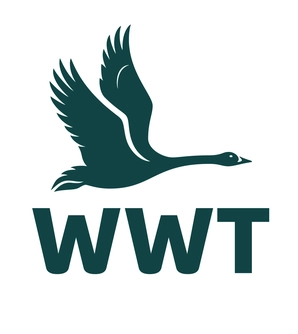
The Wildfowl & Wetlands Trust (WWT) is an international wildfowl and wetland conservation charity in the United Kingdom.
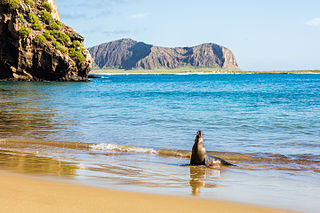
The Galápagos Islands are an archipelago of volcanic islands in the Eastern Pacific, located around the Equator 900 km (560 mi) west of the mainland of South America. They form the Galápagos Province of the Republic of Ecuador, with a population of slightly over 33,000 (2020). The province is divided into the cantons of San Cristóbal, Santa Cruz, and Isabela, the three most populated islands in the chain. The Galápagos are famous for their large number of endemic species, which were studied by Charles Darwin in the 1830s and inspired his theory of evolution by means of natural selection. All of these islands are protected as part of Ecuador's Galápagos National Park and Marine Reserve.

Darwin's finches are a group of about 18 species of passerine birds. They are well known for their remarkable diversity in beak form and function. They are often classified as the subfamily Geospizinae or tribe Geospizini. They belong to the tanager family and are not closely related to the true finches. The closest known relative of the Galápagos finches is the South American dull-coloured grassquit. They were first collected when the second voyage of the Beagle visited the Galápagos Islands, with Charles Darwin on board as a gentleman naturalist. Apart from the Cocos finch, which is from Cocos Island, the others are found only on the Galápagos Islands.
Insular biogeography or island biogeography is a field within biogeography that examines the factors that affect the species richness and diversification of isolated natural communities. The theory was originally developed to explain the pattern of the species–area relationship occurring in oceanic islands. Under either name it is now used in reference to any ecosystem that is isolated due to being surrounded by unlike ecosystems, and has been extended to mountain peaks, seamounts, oases, fragmented forests, and even natural habitats isolated by human land development. The field was started in the 1960s by the ecologists Robert H. MacArthur and E. O. Wilson, who coined the term island biogeography in their inaugural contribution to Princeton's Monograph in Population Biology series, which attempted to predict the number of species that would exist on a newly created island.

Rábida or Rabida Island is one of the Galápagos Islands. It is 5 km2 (1.9 sq mi) in area.
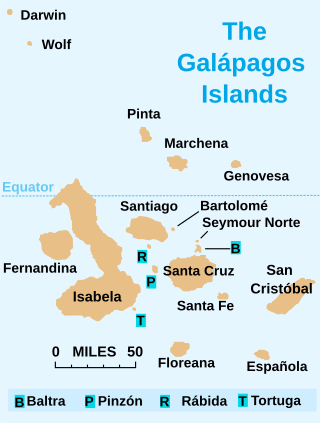
Isabela Island is the largest of the Galápagos Islands, with an area of 4,586 km2 (1,771 sq mi) and a length of 100 km (62 mi). By itself, it is larger than all the other islands in the chain combined, and it has a little under 2,000 permanent inhabitants. The island straddles the equator.

Española or Espanola Island is the most southerly of the Galápagos Islands in Ecuador, about a 10 to 12-hour trip by boat from Santa Cruz.

The Galápagos Marine Reserve (GMR) lies a thousand kilometres from the Ecuadorian mainland and covers an area of around 133,000 km2 (51,000 sq mi). The Galápagos Islands and the surrounding waters represent one of the world’s most unusual ecosystems and are rich areas of biodiversity. Recently granted UNESCO World Heritage Site status, the Galápagos Marine Reserve is the largest marine reserve in a developing country and the second largest reserve in the world.
The Galápagos Islands are located off the west coast of South America straddling the equator. The Galápagos are located at the confluence of several currents including the cold Humboldt Current traveling north from South America and the Panama Current traveling south from Central America make the islands cooler and provide the perfect environment for the unique mix of wildlife that inhabits the islands.

The Galápagos tortoise or Galápagos giant tortoise is a very large species of tortoise in the genus Chelonoidis. The species comprises 15 subspecies. It is the largest living species of tortoise, and can weigh up to 417 kg (919 lb). They are also the largest extant terrestrial cold-blooded animals (ectotherms).
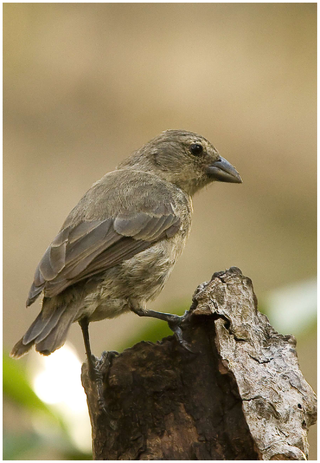
The mangrove finch is a species of bird in the Darwin's finch group of the tanager family Thraupidae. It is endemic to the Galápagos Islands. It was found on the islands of Fernandina and Isabela, but recent surveys have failed to record the species on Fernandina. It has been classified as critically endangered by BirdLife International, with an estimated population of 20–40 mature individuals in 2021, located in two large mangroves on Isabela. A study has shown that the two small populations remaining on Isabela Island have begun undergoing speciation and that one or both populations will eventually become extinct due to a lack of interbreeding.
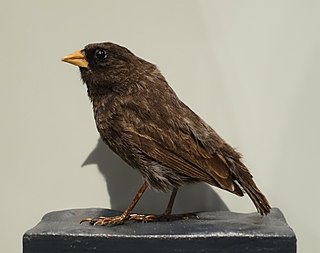
The sharp-beaked ground finch is a species of bird in the Darwin's finch group of the tanager family Thraupidae. It is classified as a least-concern species by the International Union for Conservation of Nature and it is native to the Galápagos Islands in Ecuador. It has a mass of around 20 grams (0.71 oz) and the males have black plumage, while females have streaked brown plumage. This finch was described by Richard Bowdler Sharpe in 1888.

The medium ground finch is a species of bird in the family Thraupidae. It is endemic to the Galapagos Islands. Its primary natural habitat is tropical shrubland. One of Darwin's finches, the species was the first which scientists have observed evolving in real-time.

Earthwatch Institute is an international environmental charity. It was founded in 1971 as Educational Expeditions International by Bob Citron and Clarence Truesdale. Earthwatch Institute supports Ph.D. researchers internationally and conducts over 100,000 hours of research annually using the Citizen Science methodology. Earthwatch's mission statement states that the organization "connects people with scientists worldwide to conduct environmental research and empowers them with the knowledge they need to conserve the planet." As such, it is one of the global underwriters of scientific field research in climate change, archaeology, paleontology, marine life, biodiversity, ecosystems and wildlife. For over fifty years, Earthwatch has raised funds to recruit individuals, students, teachers, and corporate fellows to participate in field research to understand nature's response to accelerating global change.

Philornis downsi, also known as the avian vampire fly, is a species of fly that was first recorded in Trinidad and Brazil in the 1990s. It has been accidentally introduced to the Galapagos Islands (Ecuador). Adults of P. downsi feed on fruit. Eggs are laid in bird nests and hatch into parasitic larvae that reside in the nest material and emerge at night to feed both internally and externally on the blood and flesh of developing nestlings. The parasite causes significant mortality in Darwin's finch nestlings and threatens the survival of some rarer species such as the mangrove finch and the medium tree finch. To protect the threatened finch populations, insecticide-laced cotton has been supplied as nesting material for the finches, with the results being highly successful in combating P. downsi infestations at a localized scale. Currently, Biological pest control agents, including Conuraannulifera, are being investigated for their potential safety and efficacy in eradicating P. downsi on the Galapagos Islands.
Island ecology is the study of island organisms and their interactions with each other and the environment. Islands account for nearly 1/6 of earth’s total land area, yet the ecology of island ecosystems is vastly different from that of mainland communities. Their isolation and high availability of empty niches lead to increased speciation. As a result, island ecosystems comprise 30% of the world’s biodiversity hotspots, 50% of marine tropical diversity, and some of the most unusual and rare species. Many species still remain unknown.

Sarah Catherine Darwin FLS is a British botanist.

The green warbler-finch is a species of bird, one of Darwin's finches in the tanager family Thraupidae. Sometimes classified in the family Emberizidae, more recent studies have shown it to belong in the tanager family.

The Project Isabela was an environmental restoration project in the Galápagos Islands of Ecuador that took place between 1997 and 2006, initiated by the Charles Darwin Foundation and the Galápagos National Park. Species introduced in the 16th and 17th centuries to the islands, mainly goats and some donkeys and pigs, brought ecological devastation to the islands and posed as a threat to the Galápagos tortoise that was by the 1990s near extinction. By 1997, plans had been officially implemented to eradicate these introduced species in northern Isabela, Santiago, and Pinta islands. Skilled park rangers used helicopters to hunt and sterilized Judas goats, fitted with radio collars to track down the feral goats. The initiative was brought into action in 1999, and by 2006, 150,000 goats alone were eradicated. As of 2011, the project was the world's largest ecological island restoration effort ever.

The Floreana giant tortoise, also known as the Charles Island giant tortoise, is an extinct subspecies of the Galápagos tortoise endemic to the Galápagos archipelago in the equatorial eastern Pacific Ocean. The specific epithet niger (‘black’) probably refers to the colouration of the holotype specimen. The species name has often been misspelled as nigra, an error introduced in the 1980s when Chelonoidis was elevated to genus and mistakenly treated as feminine, an error recognized and fixed in 2017.

















